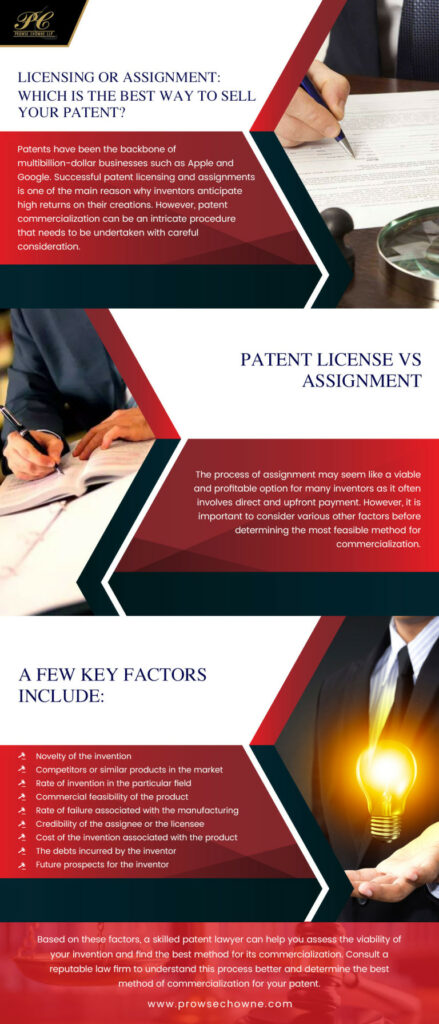Good patents can enhance the viability of a business. Owning valuable patents was a windfall to inventor Paul Brown, who earned $13 million in licensing fees for devising a valve technology. Patents have also been the backbone of multibillion-dollar businesses such as Apple and Google. Successful Intellectual Property (IP) commercialization has been crucial to promoting innovation in the economy.
These successful patent licensing and assignments is also the reason why inventors anticipate high returns on their creations. However, patent commercialization can be an intricate procedure that needs to be undertaken with careful consideration. Depending on the type, the technology and the feasibility of your invention, its method of sale can be determined.
Here’s a closer look at the process of patent license vs assignment:
What is Licensing?
Inventors can commercialize their patents in three ways:
- Licensing
- Assignment
- Direct manufacturing and distribution
Although manufacturing the inventions grants the creators complete independence over their work, most do not opt for this alternative. This is either because the inventors are not interested in the marketing aspect of their work or are not employed by an organisation that ensures ease of commercialization. Licensing is a good option for these inventors to consider.
Licensing a patent is a procedure that allows a patent owner to lease his invention and profit from it for a predetermined amount of time. In many cases, the predetermined amount of time is the period for which the patent is valid. It involves the signing of a legally binding contract which permits the licensee to utilize, copy and earn from the licensor’s work in exchange for a royalty or fixed rate. The license agreement may require specific performance obligations, specific territories, specific frequency of payments and any other information important to either party. This information may depend on the type of patent being licensed. Consulting an experienced IP lawyer can be valuable to ensure a properly drafted agreement with the intentions of the licensor and licensee properly described.
What is an Assignment?
An assignment is a sale that involves a transfer of the ownership of the patent. The inventor or owner of the patent assigns complete or partial rights of his invention to the assignee in exchange for a predetermined payment. Generally, this payment is a lump sum, however agreements with royalties, payment plans and other types of predetermined payments are possible. Once an assignment has been completed, ownership of the patent transfers to the assignee and the previous owner loses all rights to the patents.
Patent License vs Assignment
During the initial review, the process of assignment may seem like a viable and profitable option for many inventors as it often involves direct and upfront payment. However, it is important to consider various other factors before determining the most feasible method for commercialization. A few key factors include:
- Novelty of the invention
- Competitors or similar products in the market
- Rate of invention in the particular field
- Commercial feasibility of the product
- Rate of failure associated with the manufacturing
- Credibility of the assignee or the licensee
- Cost of the invention associated with the product
- The debts incurred by the inventor
- Future prospects for the inventor
Based on these factors, a skilled patent lawyer can help you assess the viability of your invention and find the best method for its commercialization. Licensing is usually considered a good option for the sale of IT patents that have future prospects in their sector. On the other hand, an assignment is profitable for patents which have mechanical practicality.
Consult a reputable law firm to understand this process better and determine the best method of commercialization for your patent.

